System Thinking Report: Analyzing Hospital Emergency Department
VerifiedAdded on 2023/03/17
|14
|3272
|36
Report
AI Summary
This report applies system thinking to analyze the operations of a hospital's emergency department. It begins with an executive summary highlighting the vital role of emergency departments and the potential consequences of operational inefficiencies. The report delves into the current value stream map, identifying key problems such as lengthy patient waiting times due to manual processes and mismanagement. Through system archetype identification, including limits to growth, eroding goals, and escalation, the analysis reveals the underlying causes of these issues. The report then proposes a new value stream map that incorporates an Electronic Health Record (EHR) system to automate processes, reduce waiting times, and improve overall efficiency. The consequences of implementing the new value stream map are discussed, emphasizing the positive impact on patient care and streamlining of operations. The report concludes with recommendations for improving the emergency department's performance.
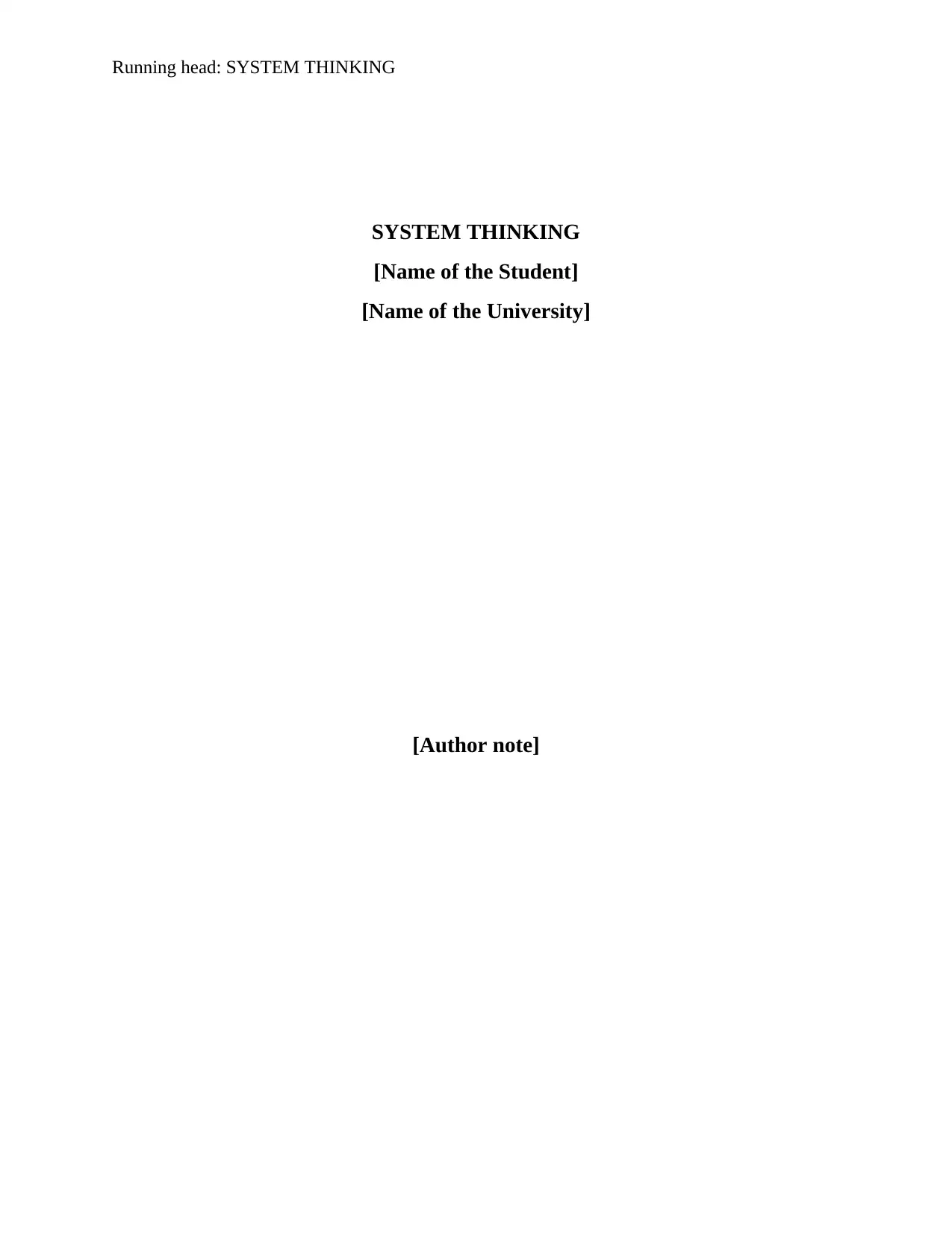
Running head: SYSTEM THINKING
SYSTEM THINKING
[Name of the Student]
[Name of the University]
[Author note]
SYSTEM THINKING
[Name of the Student]
[Name of the University]
[Author note]
Paraphrase This Document
Need a fresh take? Get an instant paraphrase of this document with our AI Paraphraser
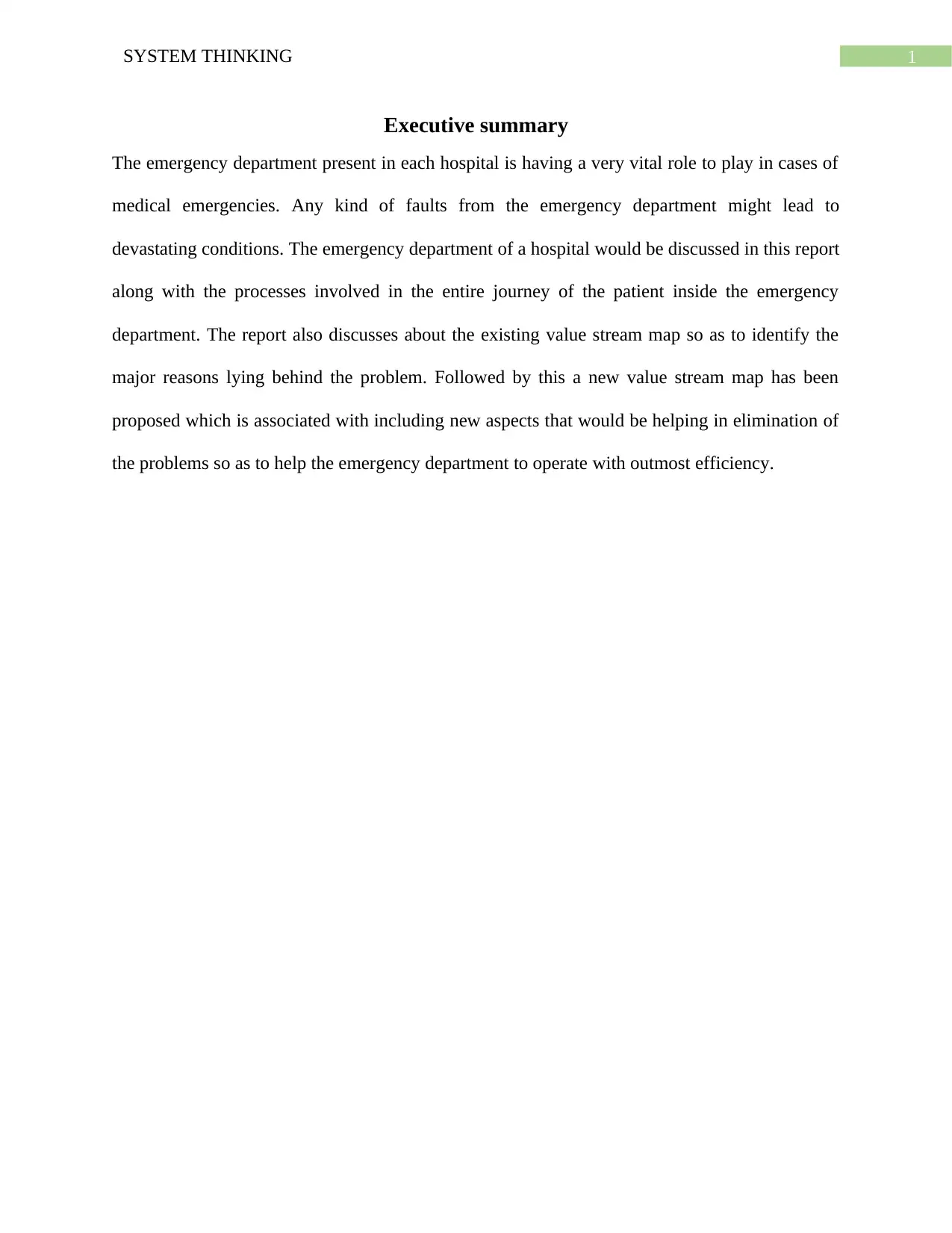
1SYSTEM THINKING
Executive summary
The emergency department present in each hospital is having a very vital role to play in cases of
medical emergencies. Any kind of faults from the emergency department might lead to
devastating conditions. The emergency department of a hospital would be discussed in this report
along with the processes involved in the entire journey of the patient inside the emergency
department. The report also discusses about the existing value stream map so as to identify the
major reasons lying behind the problem. Followed by this a new value stream map has been
proposed which is associated with including new aspects that would be helping in elimination of
the problems so as to help the emergency department to operate with outmost efficiency.
Executive summary
The emergency department present in each hospital is having a very vital role to play in cases of
medical emergencies. Any kind of faults from the emergency department might lead to
devastating conditions. The emergency department of a hospital would be discussed in this report
along with the processes involved in the entire journey of the patient inside the emergency
department. The report also discusses about the existing value stream map so as to identify the
major reasons lying behind the problem. Followed by this a new value stream map has been
proposed which is associated with including new aspects that would be helping in elimination of
the problems so as to help the emergency department to operate with outmost efficiency.
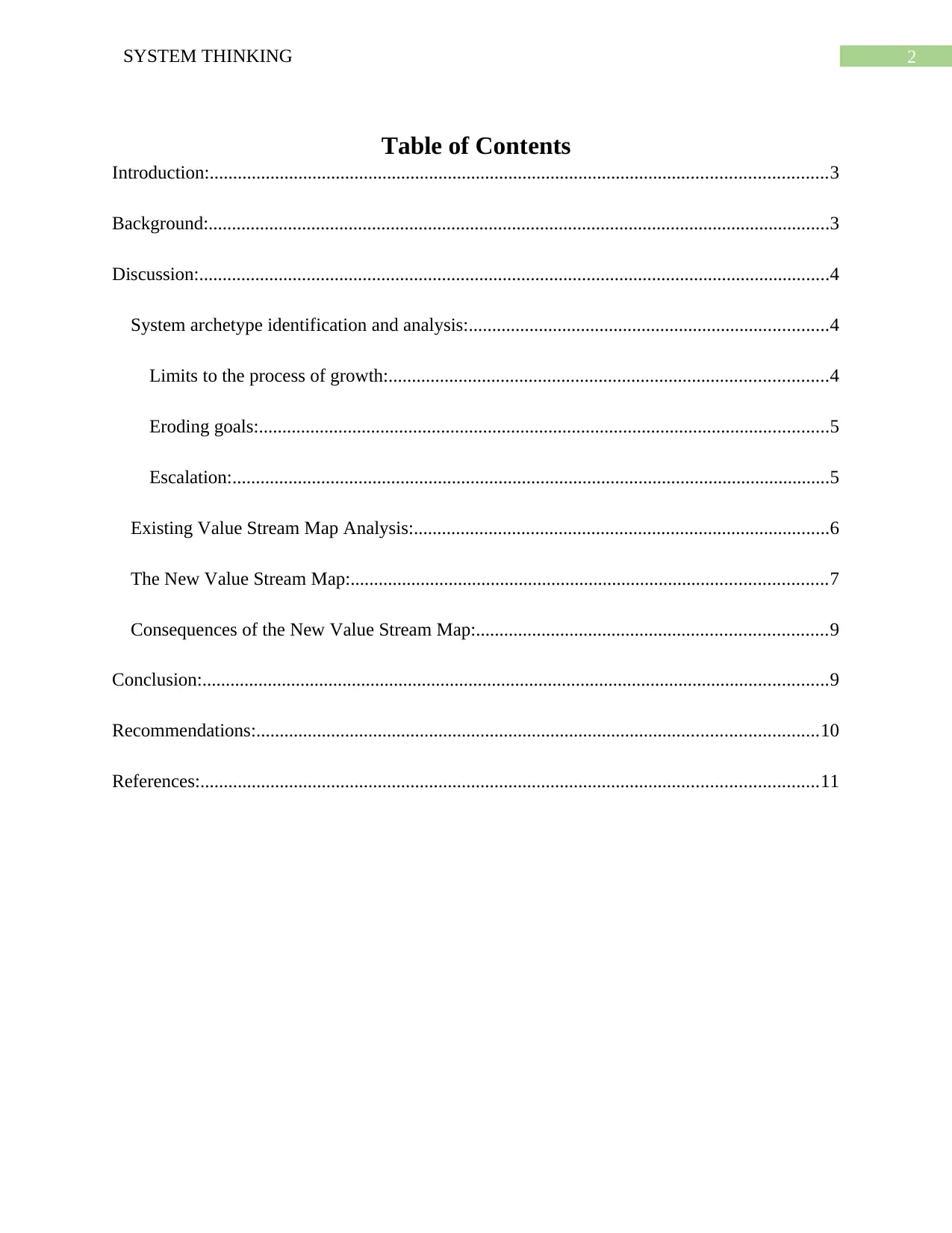
2SYSTEM THINKING
Table of Contents
Introduction:....................................................................................................................................3
Background:.....................................................................................................................................3
Discussion:.......................................................................................................................................4
System archetype identification and analysis:.............................................................................4
Limits to the process of growth:..............................................................................................4
Eroding goals:..........................................................................................................................5
Escalation:................................................................................................................................5
Existing Value Stream Map Analysis:.........................................................................................6
The New Value Stream Map:......................................................................................................7
Consequences of the New Value Stream Map:...........................................................................9
Conclusion:......................................................................................................................................9
Recommendations:........................................................................................................................10
References:....................................................................................................................................11
Table of Contents
Introduction:....................................................................................................................................3
Background:.....................................................................................................................................3
Discussion:.......................................................................................................................................4
System archetype identification and analysis:.............................................................................4
Limits to the process of growth:..............................................................................................4
Eroding goals:..........................................................................................................................5
Escalation:................................................................................................................................5
Existing Value Stream Map Analysis:.........................................................................................6
The New Value Stream Map:......................................................................................................7
Consequences of the New Value Stream Map:...........................................................................9
Conclusion:......................................................................................................................................9
Recommendations:........................................................................................................................10
References:....................................................................................................................................11
⊘ This is a preview!⊘
Do you want full access?
Subscribe today to unlock all pages.

Trusted by 1+ million students worldwide
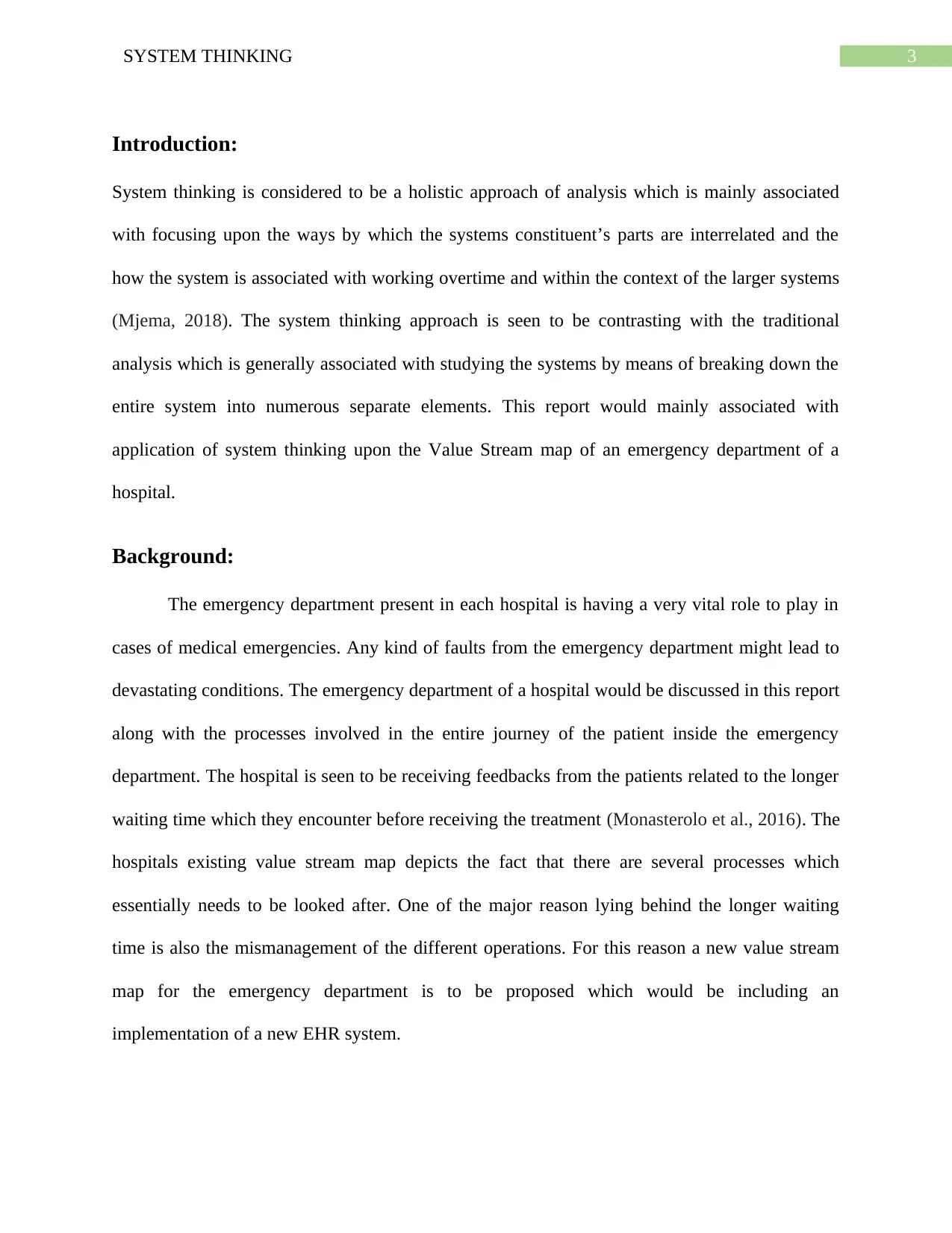
3SYSTEM THINKING
Introduction:
System thinking is considered to be a holistic approach of analysis which is mainly associated
with focusing upon the ways by which the systems constituent’s parts are interrelated and the
how the system is associated with working overtime and within the context of the larger systems
(Mjema, 2018). The system thinking approach is seen to be contrasting with the traditional
analysis which is generally associated with studying the systems by means of breaking down the
entire system into numerous separate elements. This report would mainly associated with
application of system thinking upon the Value Stream map of an emergency department of a
hospital.
Background:
The emergency department present in each hospital is having a very vital role to play in
cases of medical emergencies. Any kind of faults from the emergency department might lead to
devastating conditions. The emergency department of a hospital would be discussed in this report
along with the processes involved in the entire journey of the patient inside the emergency
department. The hospital is seen to be receiving feedbacks from the patients related to the longer
waiting time which they encounter before receiving the treatment (Monasterolo et al., 2016). The
hospitals existing value stream map depicts the fact that there are several processes which
essentially needs to be looked after. One of the major reason lying behind the longer waiting
time is also the mismanagement of the different operations. For this reason a new value stream
map for the emergency department is to be proposed which would be including an
implementation of a new EHR system.
Introduction:
System thinking is considered to be a holistic approach of analysis which is mainly associated
with focusing upon the ways by which the systems constituent’s parts are interrelated and the
how the system is associated with working overtime and within the context of the larger systems
(Mjema, 2018). The system thinking approach is seen to be contrasting with the traditional
analysis which is generally associated with studying the systems by means of breaking down the
entire system into numerous separate elements. This report would mainly associated with
application of system thinking upon the Value Stream map of an emergency department of a
hospital.
Background:
The emergency department present in each hospital is having a very vital role to play in
cases of medical emergencies. Any kind of faults from the emergency department might lead to
devastating conditions. The emergency department of a hospital would be discussed in this report
along with the processes involved in the entire journey of the patient inside the emergency
department. The hospital is seen to be receiving feedbacks from the patients related to the longer
waiting time which they encounter before receiving the treatment (Monasterolo et al., 2016). The
hospitals existing value stream map depicts the fact that there are several processes which
essentially needs to be looked after. One of the major reason lying behind the longer waiting
time is also the mismanagement of the different operations. For this reason a new value stream
map for the emergency department is to be proposed which would be including an
implementation of a new EHR system.
Paraphrase This Document
Need a fresh take? Get an instant paraphrase of this document with our AI Paraphraser
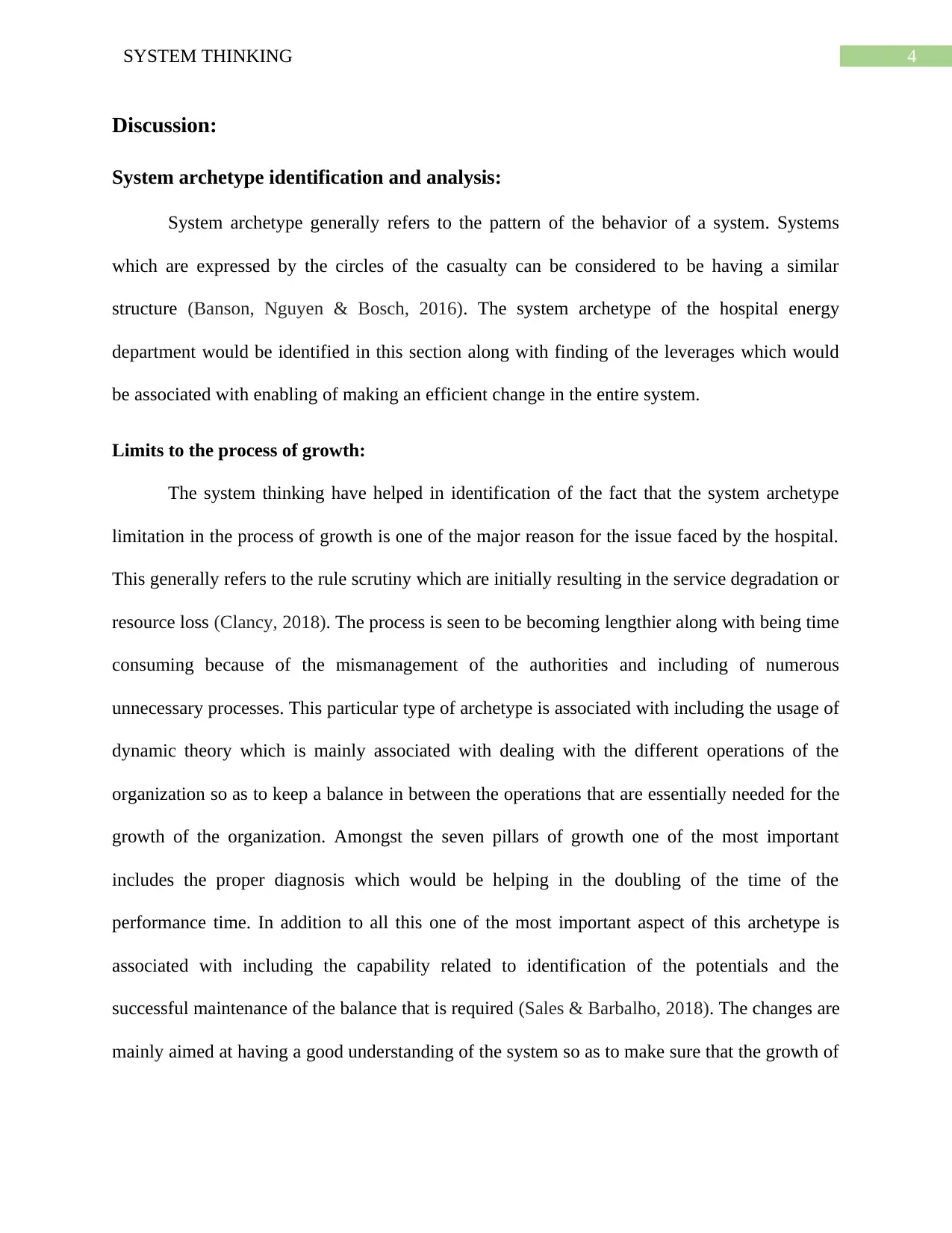
4SYSTEM THINKING
Discussion:
System archetype identification and analysis:
System archetype generally refers to the pattern of the behavior of a system. Systems
which are expressed by the circles of the casualty can be considered to be having a similar
structure (Banson, Nguyen & Bosch, 2016). The system archetype of the hospital energy
department would be identified in this section along with finding of the leverages which would
be associated with enabling of making an efficient change in the entire system.
Limits to the process of growth:
The system thinking have helped in identification of the fact that the system archetype
limitation in the process of growth is one of the major reason for the issue faced by the hospital.
This generally refers to the rule scrutiny which are initially resulting in the service degradation or
resource loss (Clancy, 2018). The process is seen to be becoming lengthier along with being time
consuming because of the mismanagement of the authorities and including of numerous
unnecessary processes. This particular type of archetype is associated with including the usage of
dynamic theory which is mainly associated with dealing with the different operations of the
organization so as to keep a balance in between the operations that are essentially needed for the
growth of the organization. Amongst the seven pillars of growth one of the most important
includes the proper diagnosis which would be helping in the doubling of the time of the
performance time. In addition to all this one of the most important aspect of this archetype is
associated with including the capability related to identification of the potentials and the
successful maintenance of the balance that is required (Sales & Barbalho, 2018). The changes are
mainly aimed at having a good understanding of the system so as to make sure that the growth of
Discussion:
System archetype identification and analysis:
System archetype generally refers to the pattern of the behavior of a system. Systems
which are expressed by the circles of the casualty can be considered to be having a similar
structure (Banson, Nguyen & Bosch, 2016). The system archetype of the hospital energy
department would be identified in this section along with finding of the leverages which would
be associated with enabling of making an efficient change in the entire system.
Limits to the process of growth:
The system thinking have helped in identification of the fact that the system archetype
limitation in the process of growth is one of the major reason for the issue faced by the hospital.
This generally refers to the rule scrutiny which are initially resulting in the service degradation or
resource loss (Clancy, 2018). The process is seen to be becoming lengthier along with being time
consuming because of the mismanagement of the authorities and including of numerous
unnecessary processes. This particular type of archetype is associated with including the usage of
dynamic theory which is mainly associated with dealing with the different operations of the
organization so as to keep a balance in between the operations that are essentially needed for the
growth of the organization. Amongst the seven pillars of growth one of the most important
includes the proper diagnosis which would be helping in the doubling of the time of the
performance time. In addition to all this one of the most important aspect of this archetype is
associated with including the capability related to identification of the potentials and the
successful maintenance of the balance that is required (Sales & Barbalho, 2018). The changes are
mainly aimed at having a good understanding of the system so as to make sure that the growth of
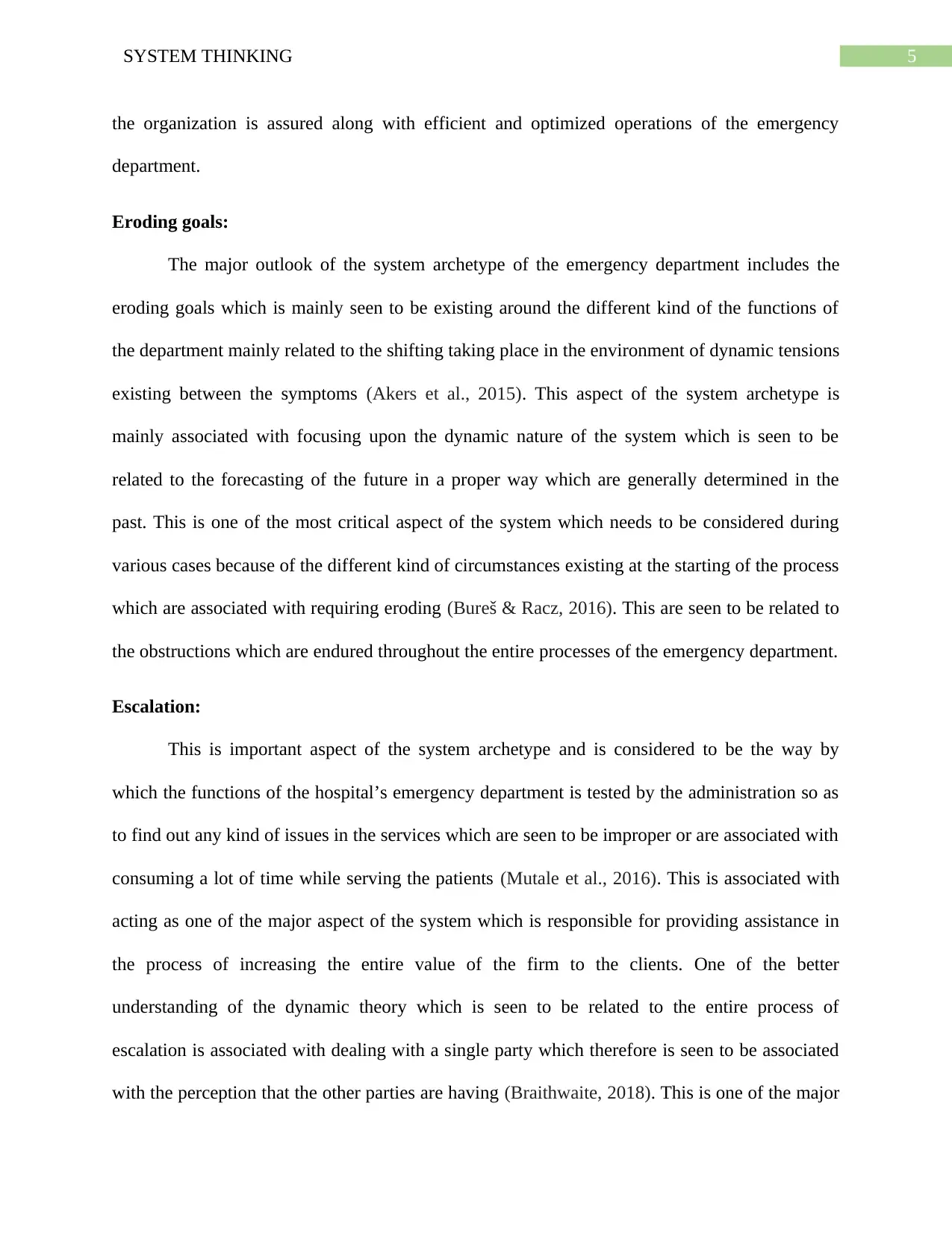
5SYSTEM THINKING
the organization is assured along with efficient and optimized operations of the emergency
department.
Eroding goals:
The major outlook of the system archetype of the emergency department includes the
eroding goals which is mainly seen to be existing around the different kind of the functions of
the department mainly related to the shifting taking place in the environment of dynamic tensions
existing between the symptoms (Akers et al., 2015). This aspect of the system archetype is
mainly associated with focusing upon the dynamic nature of the system which is seen to be
related to the forecasting of the future in a proper way which are generally determined in the
past. This is one of the most critical aspect of the system which needs to be considered during
various cases because of the different kind of circumstances existing at the starting of the process
which are associated with requiring eroding (Bureš & Racz, 2016). This are seen to be related to
the obstructions which are endured throughout the entire processes of the emergency department.
Escalation:
This is important aspect of the system archetype and is considered to be the way by
which the functions of the hospital’s emergency department is tested by the administration so as
to find out any kind of issues in the services which are seen to be improper or are associated with
consuming a lot of time while serving the patients (Mutale et al., 2016). This is associated with
acting as one of the major aspect of the system which is responsible for providing assistance in
the process of increasing the entire value of the firm to the clients. One of the better
understanding of the dynamic theory which is seen to be related to the entire process of
escalation is associated with dealing with a single party which therefore is seen to be associated
with the perception that the other parties are having (Braithwaite, 2018). This is one of the major
the organization is assured along with efficient and optimized operations of the emergency
department.
Eroding goals:
The major outlook of the system archetype of the emergency department includes the
eroding goals which is mainly seen to be existing around the different kind of the functions of
the department mainly related to the shifting taking place in the environment of dynamic tensions
existing between the symptoms (Akers et al., 2015). This aspect of the system archetype is
mainly associated with focusing upon the dynamic nature of the system which is seen to be
related to the forecasting of the future in a proper way which are generally determined in the
past. This is one of the most critical aspect of the system which needs to be considered during
various cases because of the different kind of circumstances existing at the starting of the process
which are associated with requiring eroding (Bureš & Racz, 2016). This are seen to be related to
the obstructions which are endured throughout the entire processes of the emergency department.
Escalation:
This is important aspect of the system archetype and is considered to be the way by
which the functions of the hospital’s emergency department is tested by the administration so as
to find out any kind of issues in the services which are seen to be improper or are associated with
consuming a lot of time while serving the patients (Mutale et al., 2016). This is associated with
acting as one of the major aspect of the system which is responsible for providing assistance in
the process of increasing the entire value of the firm to the clients. One of the better
understanding of the dynamic theory which is seen to be related to the entire process of
escalation is associated with dealing with a single party which therefore is seen to be associated
with the perception that the other parties are having (Braithwaite, 2018). This is one of the major
⊘ This is a preview!⊘
Do you want full access?
Subscribe today to unlock all pages.

Trusted by 1+ million students worldwide
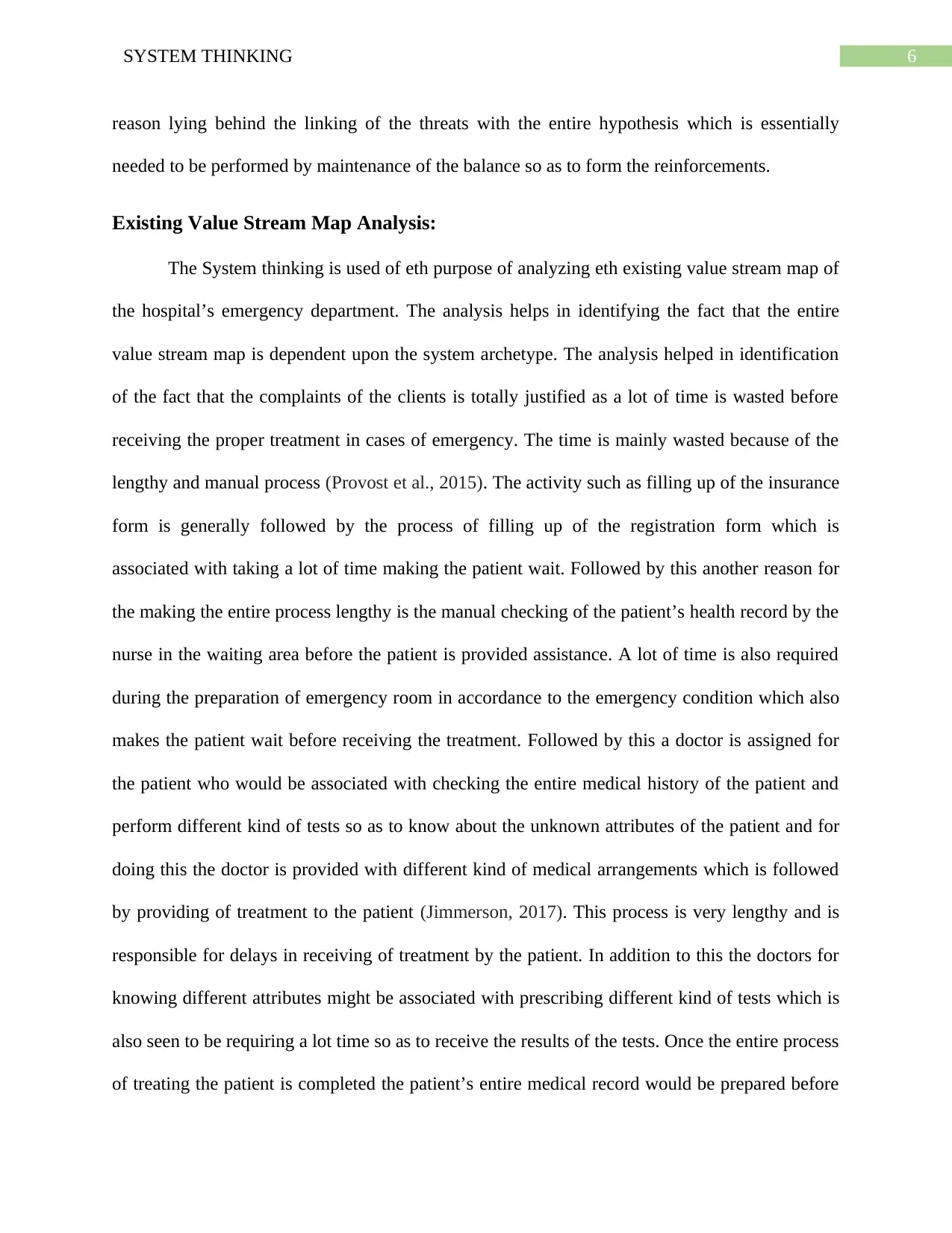
6SYSTEM THINKING
reason lying behind the linking of the threats with the entire hypothesis which is essentially
needed to be performed by maintenance of the balance so as to form the reinforcements.
Existing Value Stream Map Analysis:
The System thinking is used of eth purpose of analyzing eth existing value stream map of
the hospital’s emergency department. The analysis helps in identifying the fact that the entire
value stream map is dependent upon the system archetype. The analysis helped in identification
of the fact that the complaints of the clients is totally justified as a lot of time is wasted before
receiving the proper treatment in cases of emergency. The time is mainly wasted because of the
lengthy and manual process (Provost et al., 2015). The activity such as filling up of the insurance
form is generally followed by the process of filling up of the registration form which is
associated with taking a lot of time making the patient wait. Followed by this another reason for
the making the entire process lengthy is the manual checking of the patient’s health record by the
nurse in the waiting area before the patient is provided assistance. A lot of time is also required
during the preparation of emergency room in accordance to the emergency condition which also
makes the patient wait before receiving the treatment. Followed by this a doctor is assigned for
the patient who would be associated with checking the entire medical history of the patient and
perform different kind of tests so as to know about the unknown attributes of the patient and for
doing this the doctor is provided with different kind of medical arrangements which is followed
by providing of treatment to the patient (Jimmerson, 2017). This process is very lengthy and is
responsible for delays in receiving of treatment by the patient. In addition to this the doctors for
knowing different attributes might be associated with prescribing different kind of tests which is
also seen to be requiring a lot time so as to receive the results of the tests. Once the entire process
of treating the patient is completed the patient’s entire medical record would be prepared before
reason lying behind the linking of the threats with the entire hypothesis which is essentially
needed to be performed by maintenance of the balance so as to form the reinforcements.
Existing Value Stream Map Analysis:
The System thinking is used of eth purpose of analyzing eth existing value stream map of
the hospital’s emergency department. The analysis helps in identifying the fact that the entire
value stream map is dependent upon the system archetype. The analysis helped in identification
of the fact that the complaints of the clients is totally justified as a lot of time is wasted before
receiving the proper treatment in cases of emergency. The time is mainly wasted because of the
lengthy and manual process (Provost et al., 2015). The activity such as filling up of the insurance
form is generally followed by the process of filling up of the registration form which is
associated with taking a lot of time making the patient wait. Followed by this another reason for
the making the entire process lengthy is the manual checking of the patient’s health record by the
nurse in the waiting area before the patient is provided assistance. A lot of time is also required
during the preparation of emergency room in accordance to the emergency condition which also
makes the patient wait before receiving the treatment. Followed by this a doctor is assigned for
the patient who would be associated with checking the entire medical history of the patient and
perform different kind of tests so as to know about the unknown attributes of the patient and for
doing this the doctor is provided with different kind of medical arrangements which is followed
by providing of treatment to the patient (Jimmerson, 2017). This process is very lengthy and is
responsible for delays in receiving of treatment by the patient. In addition to this the doctors for
knowing different attributes might be associated with prescribing different kind of tests which is
also seen to be requiring a lot time so as to receive the results of the tests. Once the entire process
of treating the patient is completed the patient’s entire medical record would be prepared before
Paraphrase This Document
Need a fresh take? Get an instant paraphrase of this document with our AI Paraphraser
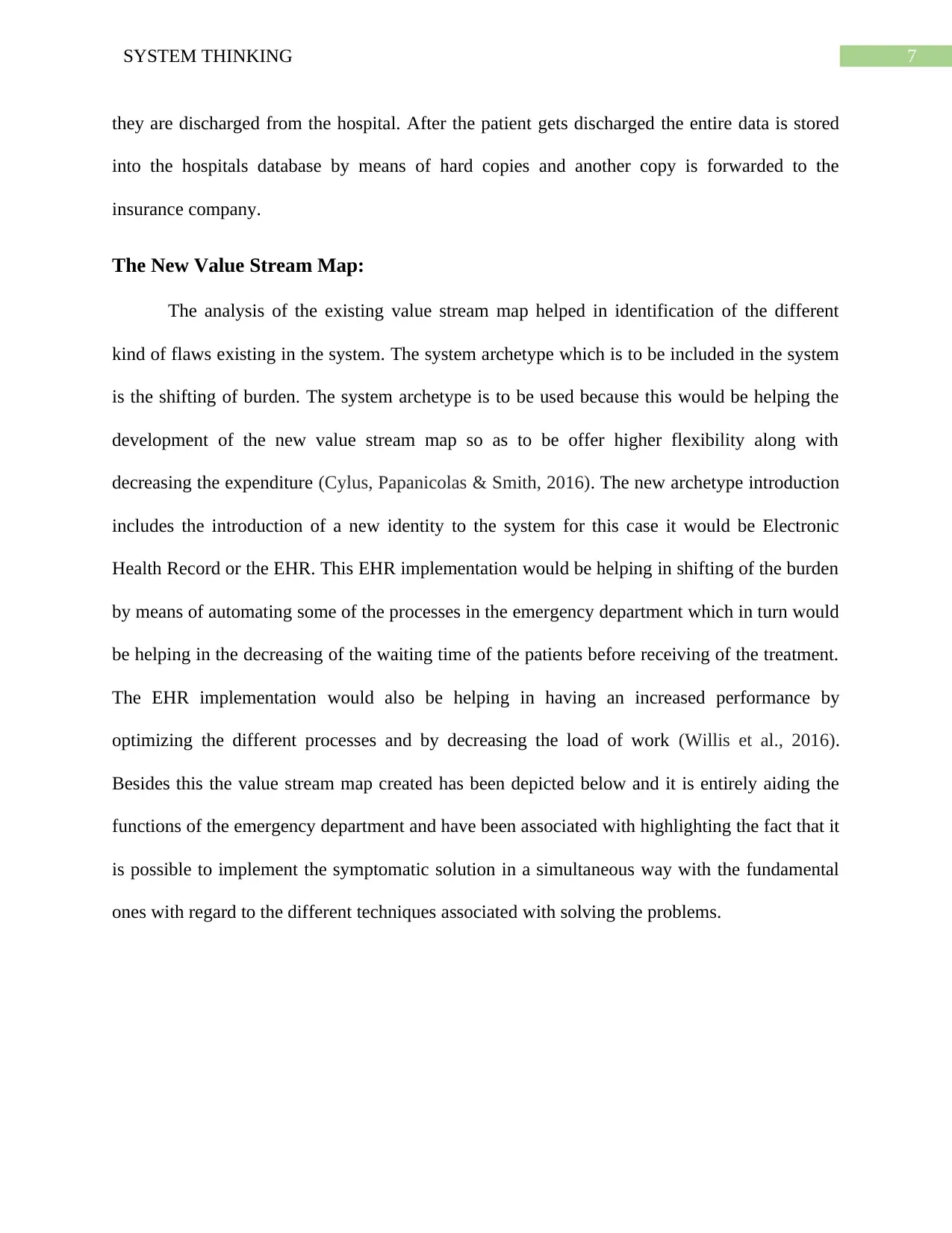
7SYSTEM THINKING
they are discharged from the hospital. After the patient gets discharged the entire data is stored
into the hospitals database by means of hard copies and another copy is forwarded to the
insurance company.
The New Value Stream Map:
The analysis of the existing value stream map helped in identification of the different
kind of flaws existing in the system. The system archetype which is to be included in the system
is the shifting of burden. The system archetype is to be used because this would be helping the
development of the new value stream map so as to be offer higher flexibility along with
decreasing the expenditure (Cylus, Papanicolas & Smith, 2016). The new archetype introduction
includes the introduction of a new identity to the system for this case it would be Electronic
Health Record or the EHR. This EHR implementation would be helping in shifting of the burden
by means of automating some of the processes in the emergency department which in turn would
be helping in the decreasing of the waiting time of the patients before receiving of the treatment.
The EHR implementation would also be helping in having an increased performance by
optimizing the different processes and by decreasing the load of work (Willis et al., 2016).
Besides this the value stream map created has been depicted below and it is entirely aiding the
functions of the emergency department and have been associated with highlighting the fact that it
is possible to implement the symptomatic solution in a simultaneous way with the fundamental
ones with regard to the different techniques associated with solving the problems.
they are discharged from the hospital. After the patient gets discharged the entire data is stored
into the hospitals database by means of hard copies and another copy is forwarded to the
insurance company.
The New Value Stream Map:
The analysis of the existing value stream map helped in identification of the different
kind of flaws existing in the system. The system archetype which is to be included in the system
is the shifting of burden. The system archetype is to be used because this would be helping the
development of the new value stream map so as to be offer higher flexibility along with
decreasing the expenditure (Cylus, Papanicolas & Smith, 2016). The new archetype introduction
includes the introduction of a new identity to the system for this case it would be Electronic
Health Record or the EHR. This EHR implementation would be helping in shifting of the burden
by means of automating some of the processes in the emergency department which in turn would
be helping in the decreasing of the waiting time of the patients before receiving of the treatment.
The EHR implementation would also be helping in having an increased performance by
optimizing the different processes and by decreasing the load of work (Willis et al., 2016).
Besides this the value stream map created has been depicted below and it is entirely aiding the
functions of the emergency department and have been associated with highlighting the fact that it
is possible to implement the symptomatic solution in a simultaneous way with the fundamental
ones with regard to the different techniques associated with solving the problems.
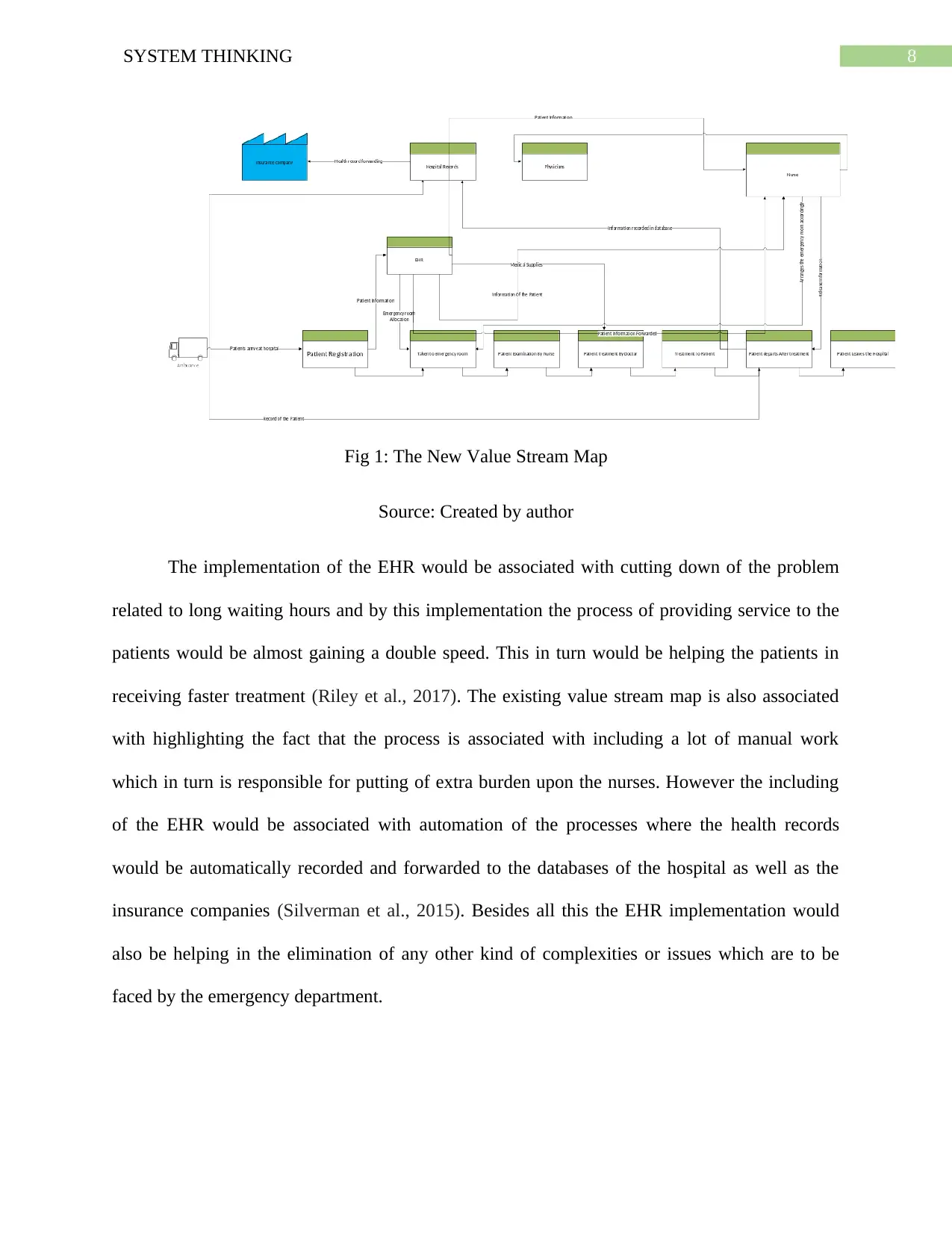
8SYSTEM THINKING
Fig 1: The New Value Stream Map
Source: Created by author
The implementation of the EHR would be associated with cutting down of the problem
related to long waiting hours and by this implementation the process of providing service to the
patients would be almost gaining a double speed. This in turn would be helping the patients in
receiving faster treatment (Riley et al., 2017). The existing value stream map is also associated
with highlighting the fact that the process is associated with including a lot of manual work
which in turn is responsible for putting of extra burden upon the nurses. However the including
of the EHR would be associated with automation of the processes where the health records
would be automatically recorded and forwarded to the databases of the hospital as well as the
insurance companies (Silverman et al., 2015). Besides all this the EHR implementation would
also be helping in the elimination of any other kind of complexities or issues which are to be
faced by the emergency department.
Fig 1: The New Value Stream Map
Source: Created by author
The implementation of the EHR would be associated with cutting down of the problem
related to long waiting hours and by this implementation the process of providing service to the
patients would be almost gaining a double speed. This in turn would be helping the patients in
receiving faster treatment (Riley et al., 2017). The existing value stream map is also associated
with highlighting the fact that the process is associated with including a lot of manual work
which in turn is responsible for putting of extra burden upon the nurses. However the including
of the EHR would be associated with automation of the processes where the health records
would be automatically recorded and forwarded to the databases of the hospital as well as the
insurance companies (Silverman et al., 2015). Besides all this the EHR implementation would
also be helping in the elimination of any other kind of complexities or issues which are to be
faced by the emergency department.
⊘ This is a preview!⊘
Do you want full access?
Subscribe today to unlock all pages.

Trusted by 1+ million students worldwide
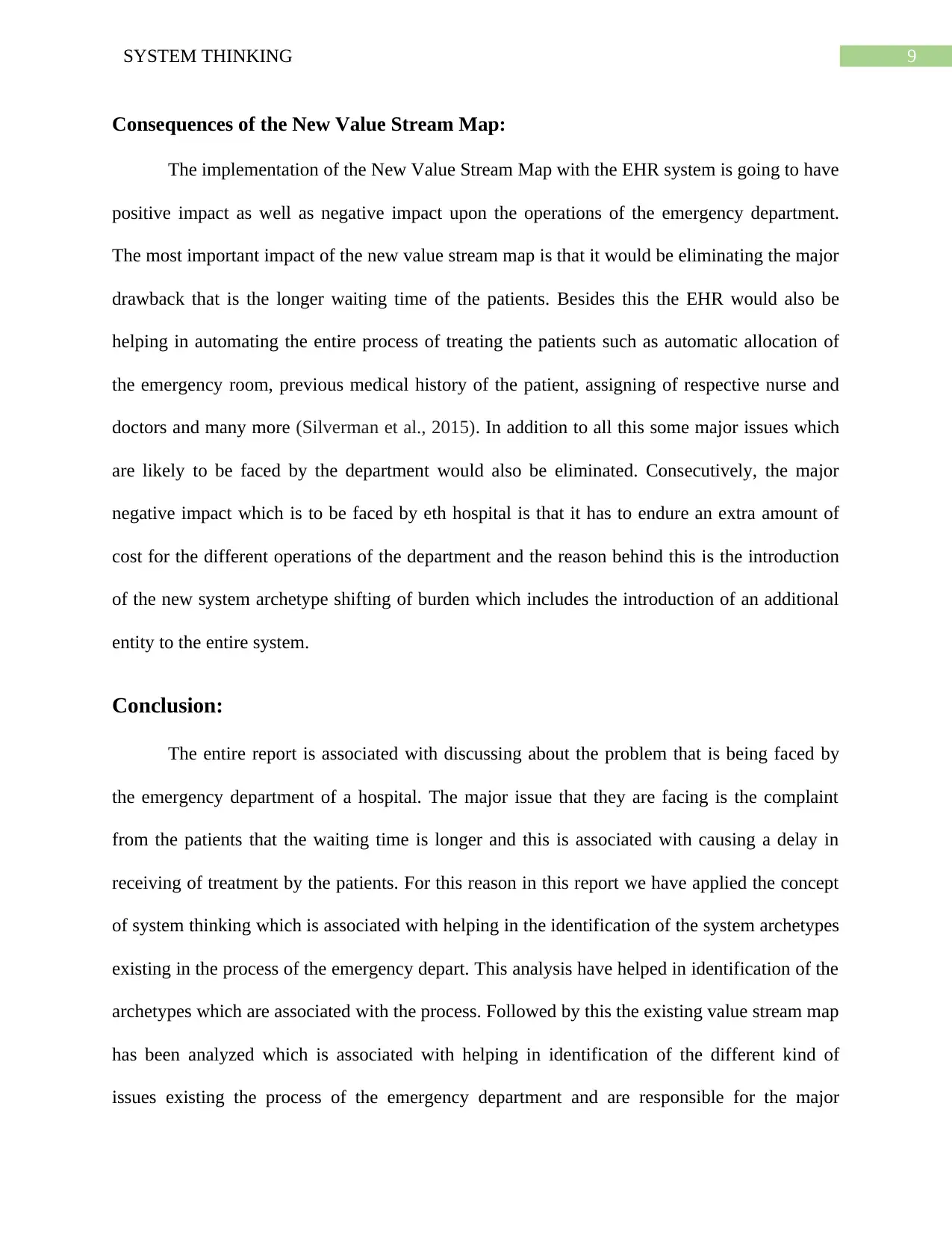
9SYSTEM THINKING
Consequences of the New Value Stream Map:
The implementation of the New Value Stream Map with the EHR system is going to have
positive impact as well as negative impact upon the operations of the emergency department.
The most important impact of the new value stream map is that it would be eliminating the major
drawback that is the longer waiting time of the patients. Besides this the EHR would also be
helping in automating the entire process of treating the patients such as automatic allocation of
the emergency room, previous medical history of the patient, assigning of respective nurse and
doctors and many more (Silverman et al., 2015). In addition to all this some major issues which
are likely to be faced by the department would also be eliminated. Consecutively, the major
negative impact which is to be faced by eth hospital is that it has to endure an extra amount of
cost for the different operations of the department and the reason behind this is the introduction
of the new system archetype shifting of burden which includes the introduction of an additional
entity to the entire system.
Conclusion:
The entire report is associated with discussing about the problem that is being faced by
the emergency department of a hospital. The major issue that they are facing is the complaint
from the patients that the waiting time is longer and this is associated with causing a delay in
receiving of treatment by the patients. For this reason in this report we have applied the concept
of system thinking which is associated with helping in the identification of the system archetypes
existing in the process of the emergency depart. This analysis have helped in identification of the
archetypes which are associated with the process. Followed by this the existing value stream map
has been analyzed which is associated with helping in identification of the different kind of
issues existing the process of the emergency department and are responsible for the major
Consequences of the New Value Stream Map:
The implementation of the New Value Stream Map with the EHR system is going to have
positive impact as well as negative impact upon the operations of the emergency department.
The most important impact of the new value stream map is that it would be eliminating the major
drawback that is the longer waiting time of the patients. Besides this the EHR would also be
helping in automating the entire process of treating the patients such as automatic allocation of
the emergency room, previous medical history of the patient, assigning of respective nurse and
doctors and many more (Silverman et al., 2015). In addition to all this some major issues which
are likely to be faced by the department would also be eliminated. Consecutively, the major
negative impact which is to be faced by eth hospital is that it has to endure an extra amount of
cost for the different operations of the department and the reason behind this is the introduction
of the new system archetype shifting of burden which includes the introduction of an additional
entity to the entire system.
Conclusion:
The entire report is associated with discussing about the problem that is being faced by
the emergency department of a hospital. The major issue that they are facing is the complaint
from the patients that the waiting time is longer and this is associated with causing a delay in
receiving of treatment by the patients. For this reason in this report we have applied the concept
of system thinking which is associated with helping in the identification of the system archetypes
existing in the process of the emergency depart. This analysis have helped in identification of the
archetypes which are associated with the process. Followed by this the existing value stream map
has been analyzed which is associated with helping in identification of the different kind of
issues existing the process of the emergency department and are responsible for the major
Paraphrase This Document
Need a fresh take? Get an instant paraphrase of this document with our AI Paraphraser
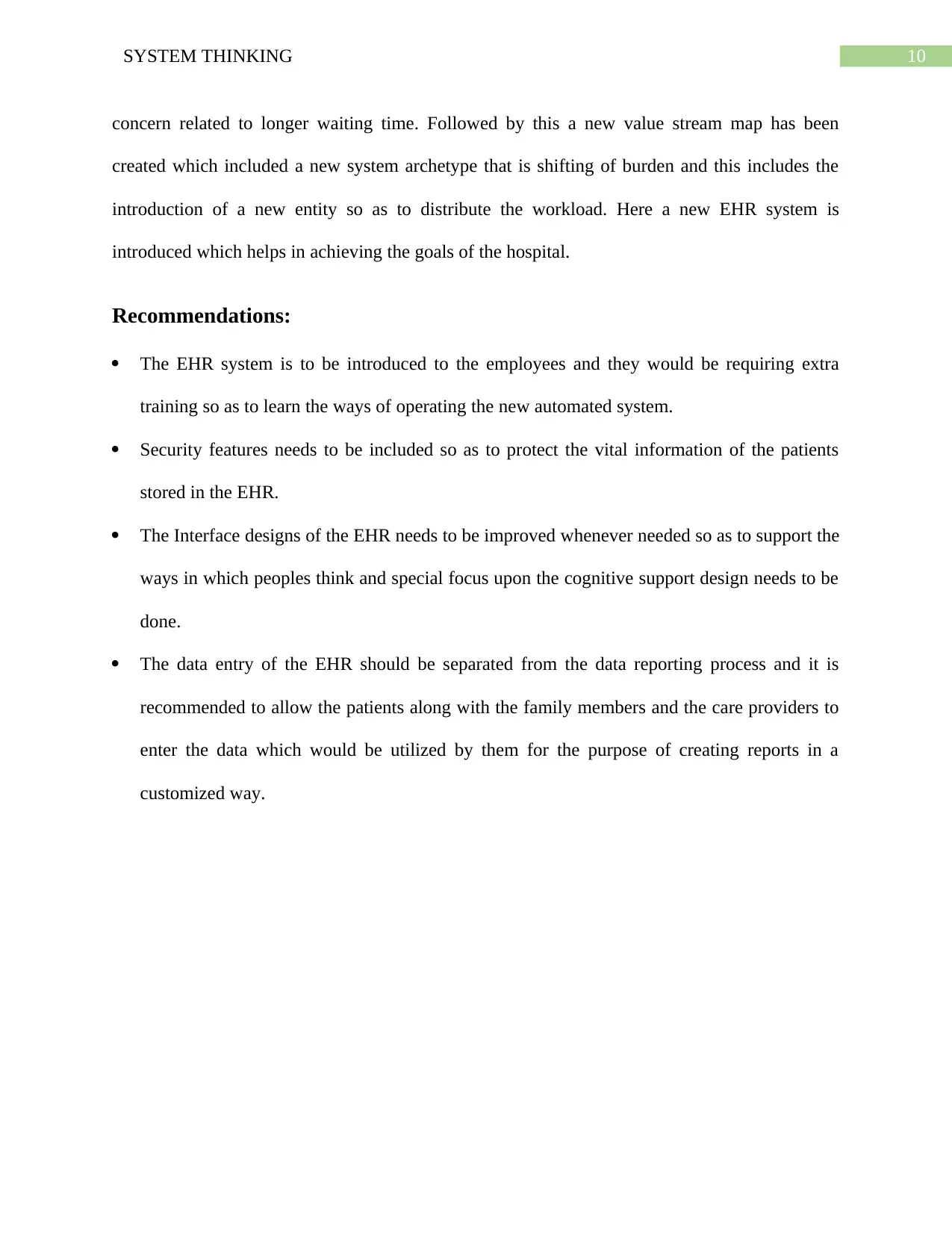
10SYSTEM THINKING
concern related to longer waiting time. Followed by this a new value stream map has been
created which included a new system archetype that is shifting of burden and this includes the
introduction of a new entity so as to distribute the workload. Here a new EHR system is
introduced which helps in achieving the goals of the hospital.
Recommendations:
The EHR system is to be introduced to the employees and they would be requiring extra
training so as to learn the ways of operating the new automated system.
Security features needs to be included so as to protect the vital information of the patients
stored in the EHR.
The Interface designs of the EHR needs to be improved whenever needed so as to support the
ways in which peoples think and special focus upon the cognitive support design needs to be
done.
The data entry of the EHR should be separated from the data reporting process and it is
recommended to allow the patients along with the family members and the care providers to
enter the data which would be utilized by them for the purpose of creating reports in a
customized way.
concern related to longer waiting time. Followed by this a new value stream map has been
created which included a new system archetype that is shifting of burden and this includes the
introduction of a new entity so as to distribute the workload. Here a new EHR system is
introduced which helps in achieving the goals of the hospital.
Recommendations:
The EHR system is to be introduced to the employees and they would be requiring extra
training so as to learn the ways of operating the new automated system.
Security features needs to be included so as to protect the vital information of the patients
stored in the EHR.
The Interface designs of the EHR needs to be improved whenever needed so as to support the
ways in which peoples think and special focus upon the cognitive support design needs to be
done.
The data entry of the EHR should be separated from the data reporting process and it is
recommended to allow the patients along with the family members and the care providers to
enter the data which would be utilized by them for the purpose of creating reports in a
customized way.
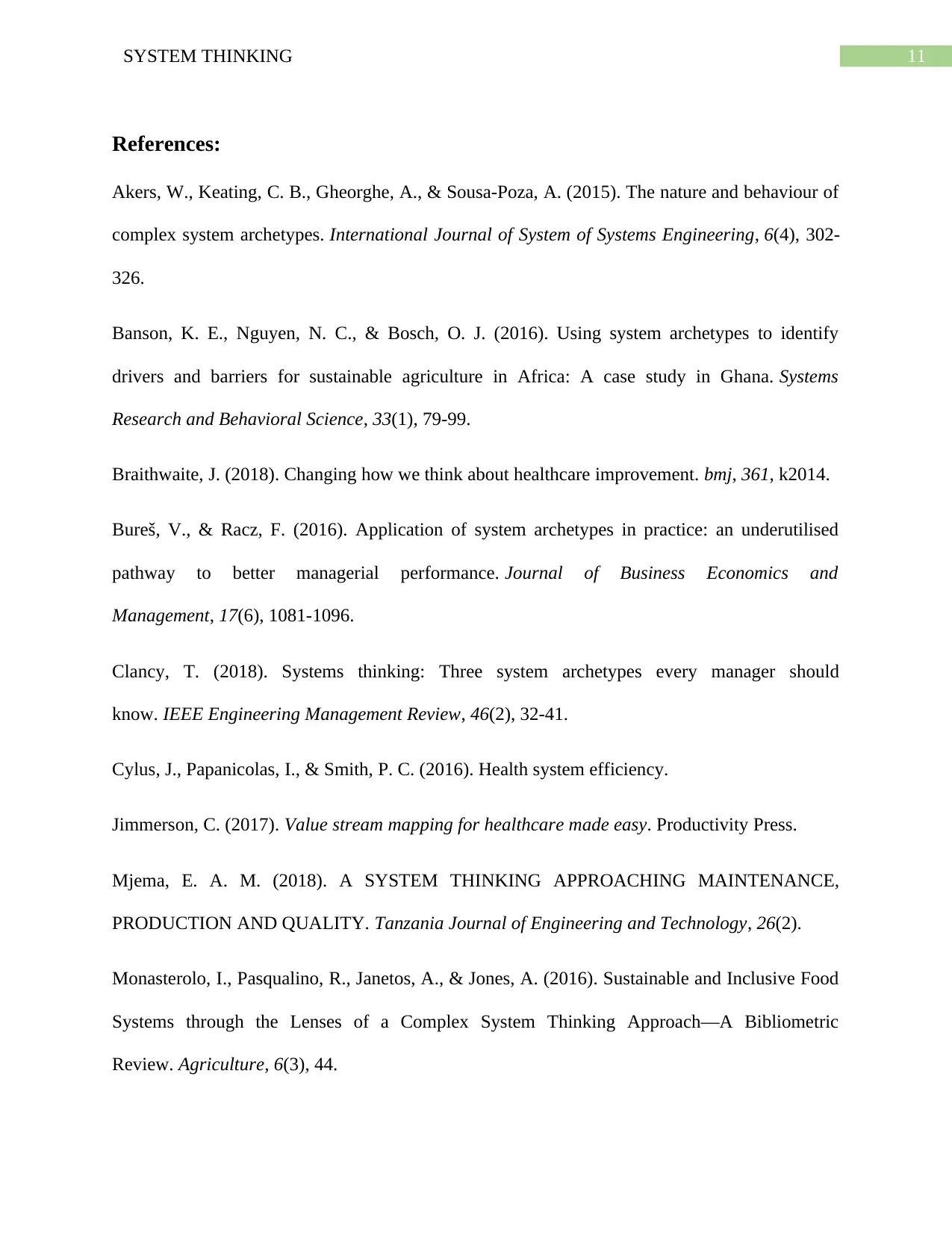
11SYSTEM THINKING
References:
Akers, W., Keating, C. B., Gheorghe, A., & Sousa-Poza, A. (2015). The nature and behaviour of
complex system archetypes. International Journal of System of Systems Engineering, 6(4), 302-
326.
Banson, K. E., Nguyen, N. C., & Bosch, O. J. (2016). Using system archetypes to identify
drivers and barriers for sustainable agriculture in Africa: A case study in Ghana. Systems
Research and Behavioral Science, 33(1), 79-99.
Braithwaite, J. (2018). Changing how we think about healthcare improvement. bmj, 361, k2014.
Bureš, V., & Racz, F. (2016). Application of system archetypes in practice: an underutilised
pathway to better managerial performance. Journal of Business Economics and
Management, 17(6), 1081-1096.
Clancy, T. (2018). Systems thinking: Three system archetypes every manager should
know. IEEE Engineering Management Review, 46(2), 32-41.
Cylus, J., Papanicolas, I., & Smith, P. C. (2016). Health system efficiency.
Jimmerson, C. (2017). Value stream mapping for healthcare made easy. Productivity Press.
Mjema, E. A. M. (2018). A SYSTEM THINKING APPROACHING MAINTENANCE,
PRODUCTION AND QUALITY. Tanzania Journal of Engineering and Technology, 26(2).
Monasterolo, I., Pasqualino, R., Janetos, A., & Jones, A. (2016). Sustainable and Inclusive Food
Systems through the Lenses of a Complex System Thinking Approach—A Bibliometric
Review. Agriculture, 6(3), 44.
References:
Akers, W., Keating, C. B., Gheorghe, A., & Sousa-Poza, A. (2015). The nature and behaviour of
complex system archetypes. International Journal of System of Systems Engineering, 6(4), 302-
326.
Banson, K. E., Nguyen, N. C., & Bosch, O. J. (2016). Using system archetypes to identify
drivers and barriers for sustainable agriculture in Africa: A case study in Ghana. Systems
Research and Behavioral Science, 33(1), 79-99.
Braithwaite, J. (2018). Changing how we think about healthcare improvement. bmj, 361, k2014.
Bureš, V., & Racz, F. (2016). Application of system archetypes in practice: an underutilised
pathway to better managerial performance. Journal of Business Economics and
Management, 17(6), 1081-1096.
Clancy, T. (2018). Systems thinking: Three system archetypes every manager should
know. IEEE Engineering Management Review, 46(2), 32-41.
Cylus, J., Papanicolas, I., & Smith, P. C. (2016). Health system efficiency.
Jimmerson, C. (2017). Value stream mapping for healthcare made easy. Productivity Press.
Mjema, E. A. M. (2018). A SYSTEM THINKING APPROACHING MAINTENANCE,
PRODUCTION AND QUALITY. Tanzania Journal of Engineering and Technology, 26(2).
Monasterolo, I., Pasqualino, R., Janetos, A., & Jones, A. (2016). Sustainable and Inclusive Food
Systems through the Lenses of a Complex System Thinking Approach—A Bibliometric
Review. Agriculture, 6(3), 44.
⊘ This is a preview!⊘
Do you want full access?
Subscribe today to unlock all pages.

Trusted by 1+ million students worldwide
1 out of 14
Related Documents
Your All-in-One AI-Powered Toolkit for Academic Success.
+13062052269
info@desklib.com
Available 24*7 on WhatsApp / Email
![[object Object]](/_next/static/media/star-bottom.7253800d.svg)
Unlock your academic potential
Copyright © 2020–2025 A2Z Services. All Rights Reserved. Developed and managed by ZUCOL.





